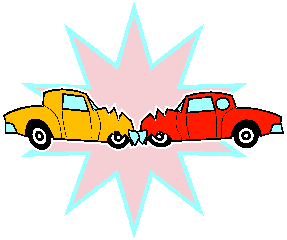Physics:
Car Collisions

Car Collisions

http://www.inkity.com/catalog/product/2/8527/Car-Collision.html

http://www.inkity.com/catalog/product/2/8527/Car-Collision.html
To explain how these concepts relate in car collisions lets take a look first at force and how much is needed to stop a car in a distance of 100 meters.
A 2003 Kia Spectra weighs 2,718 lbs which would give us 1232.864 kg
so mass (m)= 1232.9 kg
If the Kia was driving at 45 mph which is approximately 72 km/h.
initial V0= 20 m/s
To find force we will use Newton's 2nd law: F=ma
we know the mass already but we need to find acceleration and we can do so by rearranging a the kinematics equation: v²= v0²+ 2a (x-x0) to a= v²-v0²/2(x-x0)
a= (0)²- (20 m/s)²/
2(100m) = - 2m/s²
Then we can use Newton's second law to find the force:
F=ma=(1232.9 kg)(2m/s)= 2465.8 N to stop the car
Then we can use Newton's second law to find the force:
F=ma=(1232.9 kg)(2m/s)= 2465.8 N to stop the car
The momentum of the Kia traveling at 45 mph is:
P=m*v= (1232.9 kg)(20 m/s) = 24658 kg*m/s or 2.5 x 10^4 kg*m/s
This is important because the total change in momentum is equal to the impulse.
Impulse= F * the change in time
If the Kia had the same impulse but came to 0 m/s in a shorter amount of time the force would be much higher than if it took a longer amount of time to reach 0 m/s.
Crumple zones in cars are used for this very reason. They help to slow down the rate of change in momentum of the car thus lowering the impact force on the passenger. Seat belts are also used to lower the force exerted on the passenger by changing the time of impact.

http://www.aip.org/dbis/stories/2004/14124.html